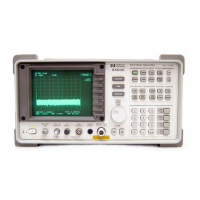336 Chapter6
General Troubleshooting
Block Diagram Description
The HP 8560E/EC uses trace-data manipulation to generate the 5
dB/DIV scale from the 10 dB/DIV scale. The A3 interface assembly
amplifies and offsets the 10 dB/DIV video to generate the 2 dB/DIV
scale. The 1 dB/DIV scale is generated from the 2 dB/DIV scale through
trace data manipulation.
The first 50 dB of IF gain (log and linear mode) is achieved using the
linear step-gain amplifiers of the A5 assembly. The A4 assembly
video-offset circuit provides the remaining 60 dB of log mode IF gain.
The A4 assembly linear amplifiers provide 40 dB of linear mode gain.
IF gain steps of less than 10 dB (regardless of the reference level) are
accomplished on the A5 assembly.
A4 Log Amplifier/Cal Oscillator Assembly
The A4 log amplifier has separate log and linear amplifier paths. After
amplification, the signal path consists of a linear detector, video log
amp, buffer amplifier, video offset, and video buffer amplifier. Other
auxiliary functions include the frequency counter prescaler/conditioner,
the AM/FM demodulator, and down-conversion to 4.8 kHz for digital
resolution bandwidths of 1 Hz through 100 Hz.
The cal oscillator, which is part of A4, supplies the stimulus signal for
automatic IF adjustments. Normally, the oscillator operates only during
retrace (for a few milliseconds) to adjust part of the IF. (All IF
parameters will be re-adjusted approximately every five minutes.) With
continuous IF adjust on, a group of IF parameters are adjusted during
each retrace period (non-disruptive). If continuous IF adjust is off, the
most recent IF calibration data will be used.
The IF parameters adjusted include step gains, log amplifier gain and
offset, bandwidth centering, 3 dB bandwidth, bandwidth amplitude,
crystal-filter symmetry, and oscillator frequency used in 1 Hz through
100 Hz resolution bandwidths.
The cal oscillator output has three forms (all −35 dBm):
• 10.7 MHz
• 9.9 to 11.5 MHz in 100 kHz steps
• Frequency sweeps from 20 kHz to 2 kHz centered at 10.7 MHz
(lasting 5 to 60 ms respectively)
The purpose of these signals is to:
• adjust gains, log amps, and video slopes and offsets
• adjust 3 dB bandwidth and center frequencies of LC resolution BW
filters (30 kHz through 1 MHz)
• adjust 3 dB bandwidth, symmetry, and gain of the crystal resolution
BW filters (300 Hz through 10 kHz)

